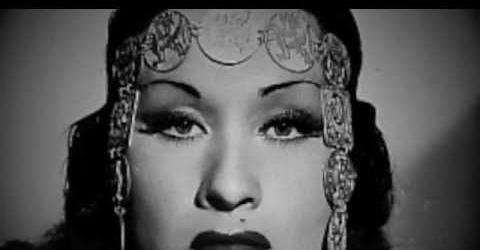Rihanna’s House of Shame
No, not Rihanna, but a major forebear: the incomparable
Yma Sumac
I feel no shame in admitting I was mesmerized by Rihanna’s Savage X Fenty Show vol. 3, which I saw on Amazon Prime, and where I devoured her combination performance-piece-infomercial-erotic-underwear-fashion-show, and which democratically offered something for every clothing size. As a matter a fact, I’m sitting here at this very moment garbed in one of her low-cost Juicy Purple silk undershorts, available at an extremely reasonable price on amazon.com. (I work at home.)
Nevertheless, after a long absence from Facebook, I returned to it to complain. I may have been snared by the mishmash of synchronized Riefenstahl-style body worship in her video. This video’s objectification of the human body transcended the hierarchical allure radiated by Greek classical statuary without suggesting hierarchy and did put me in a sexualized trance. I was also happy to discover that physical fascination and libidinal group hypnosis seemed to have made a comeback without the accompanying disturbing politics that Mme Riefenstahl featured.
One thing, however, left me fuming: The video starts with an uncredited song, “Gopher Mambo,” by Yma Sumac, the immensely popular 5-octave songbird from the 1950s who died in the first decade of this century. Anyone watching the Savage X Fenty Show vol. 3 who is not familiar with the music of Yma Sumac, which I’d assume includes the majority of all those under the age of sixty or so, would have thought that the woman lip-syncing the song in that video was actually singing it.
For those same people under 60, I offer a few facts: Back in the 70s, my friends and I swallowed whole a myth about Yma Sumac and actually believed she was a Jewish girl from Brooklyn named Amy Camus (“Yma Sumac” spelled backwards). Our trust in that legend put her at the center of the camp clowning we indulged in during those days—just as the Warholian generation before us had enshrined Maria Montez (parodied by Mario Montez in some early films by Warhol) and made her Technicolor fairytale Cobra Woman (1944) a parody favorite, a running joke echoed by Gore Vidal at the start of his sequel to Myra Breckinridge, entitled Myron (1974).
So durable was the myth about Yma Sumac actually being a Jewish-American from Brooklyn named Amy Camus that by the 1980s, my currently much-missed, deceased friend and mentor Manuel Puig* had conceived the treatment for a musical comedy that seriously interested Madonna as a potential vehicle and that hinged on the same confusion of mistaken identity. In that proposed film, which was never made, Madonna would have played a similar character from Brooklyn who masquerades as a similar Latin American songbird (although where Madonna was going to find that 5-octave range was a mystery to me).
Manuel’s playful idea was intended to provide ample opportunities for the kind of comedy previously exhibited in a few dozen Hollywood films of the past—for example, when Eleanor Powell’s character Irene from Albany masquerades as French star LaBelle Arlette in Broadway Melody of 1936; or when Tony Curtis and Jack Lemmon disguise themselves as flappers in Some Like It Hot. It was only after Manuel’s death in 1990 that I learned that Yma Sumac was indeed the real thing and could have sung grand opera with her powerful voice.
Why, I now demand, is the song by Yma Sumac that opens the video of the Savage X Fenty Show vol. 3 completely uncredited! We old fogies are perfectly happy nurturing the young with our rich legacy, but that does not mean you can bite into our nurturing breasts without so much as an acknowledgment! Is it not a copyright violation to steal that incredible song, which you can listen to here:
https://www.youtube.com/watch?v=7JWxNqyIRtk
And while you're at it, check out Yma's 1956 album cover (see above), bearing a more than coincidental resemblance to Rihanna's latest lines of fashion and her own personal look.
Manuel Puig: Argentine author of the novel Kiss of the Spiderwoman and other brilliant novels and plays, who was a powerful influence on my creative life.
